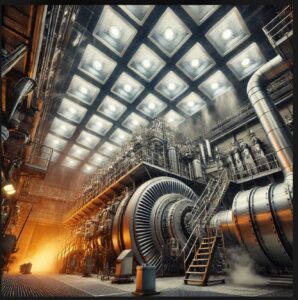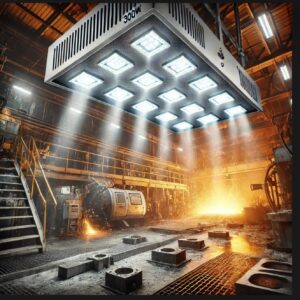The steel mill rolling workshop is one of the most demanding work environments in the industrial sector. In this environment, lighting equipment must not only withstand sustained high temperatures exceeding 200°C but also endure the corrosion of metal dust, mechanical vibrations, and strong electromagnetic interference. Traditional high-pressure sodium (HPS) lamps and metal halide lamps often perform poorly under these extreme conditions: glass housings are prone to cracking, electronic ballasts frequently fail, lamp life is significantly shortened, and maintenance costs remain high. More importantly, the sudden failure of lighting equipment can create safety hazards and disrupt normal production.
In recent years, with breakthroughs in LED technology, high-temperature-resistant LED lighting solutions specifically designed for extreme industrial environments have emerged. These lights utilize innovative materials science and thermal management technologies, enabling stable operation at temperatures as high as 200°C while offering excellent dustproof and shock-resistant performance. This article will explore the technical characteristics of high-temperature-resistant LEDs, analyze their advantages in rolling workshops, and validate their exceptional performance through real-world cases, providing a reliable technological reference for lighting renovations in the metallurgy industry.
The core technological breakthroughs in high-temperature-resistant LED lighting systems focus on three key aspects: chip packaging, thermal management, and protective design.
Regarding chip packaging technology, the most notable advancement is the adoption of Gold Wire Free packaging. Traditional LEDs use 0.025mm diameter gold wires to connect the chip and the base, but under high temperatures, these gold wires gradually become brittle and break. The new packaging technology uses flip-chip technology, where the electrical connection is made via microbumps, completely eliminating the weak link of gold wires. Furthermore, the chips use aluminum nitride ceramic substrates instead of standard aluminum-based boards, increasing thermal conductivity to above 200W/(m·K), effectively dissipating heat generated by the chip.
The innovation in thermal management systems is also crucial. The light fixtures are constructed with aviation-grade aluminum alloy heat sinks that feature a 60% larger surface area compared to traditional designs. Coupled with specially designed convection channels, the thermal resistance is reduced to below 1.5°C/W. Notably, the application of a temperature-stabilizing coating containing nano zirconium oxide composite material forms a protective layer on the surface of the light fixtures, reducing the oxidation rate by 80%, thereby significantly extending the life of the lighting system.
Regarding protective design, the high-temperature-resistant LEDs achieve an IP67 protection rating, using stainless steel fasteners and silicone rubber seals to form multi-layer dustproof barriers. The optical components are made from fused quartz glass, which not only withstands high temperatures but also resists the impact of metal debris. The power modules are separated from the light sources and placed in cooler areas, and high-temperature-rated electrolytic capacitors (105°C rated) and metal-film resistors are used to ensure reliable operation of the drive circuit.
In extreme environments like rolling workshops, high-temperature-resistant LEDs demonstrate comprehensive performance advantages.
In terms of stability and lifespan, test data shows that after 10,000 hours of continuous operation at an ambient temperature of 200°C, the LED lumen maintenance remains above 95%, far surpassing the 60% lumen maintenance of high-pressure sodium lamps. This is attributed to the solid-state lighting nature of LEDs, which lack fragile components like filaments and glass. A steel plant’s practical application showed that the average fault-free operating time of high-temperature-resistant LEDs exceeded 50,000 hours, more than six times that of traditional lamps, significantly reducing the frequency of replacements.
The energy efficiency of high-temperature LEDs is equally impressive. For example, a 150W LED fixture replacing a 400W high-pressure sodium lamp saves up to 1,800 kWh annually, achieving an energy-saving rate of 62%. Due to the directional light emission characteristic of LEDs, light utilization efficiency increases by over 40%. More notably, the light decay of LEDs in high-temperature environments is far lower than that of traditional light sources, maintaining over 85% of initial light output at 200°C, while high-pressure sodium lamps may experience a 50% drop in efficacy at the same temperature.
Safety performance is also enhanced. LED lamps operate at temperatures 70-100°C lower than high-pressure sodium lamps, keeping the surface temperature within safe limits and reducing the risk of burns. Additionally, LEDs do not contain harmful substances such as mercury, do not produce ultraviolet radiation, and have their blue light component controlled to meet the latest industrial lighting safety standards. In the event of a sudden power outage, LEDs can be equipped with an emergency power module, providing at least 30 minutes of escape lighting, a feature difficult to achieve with traditional light sources.
A compelling case is provided by a major steel group’s hot rolling mill renovation project. The mill previously used 320 sets of 400W high-pressure sodium lamps, which not only consumed high energy but also required 3-4 full-line shutdowns for maintenance each month, severely affecting production efficiency. After renovation, 200 sets of 150W high-temperature-resistant LED lamps were installed, yielding significant results.
Energy consumption data shows that the total power of the lighting system decreased from 128kW to 30kW, with an annual electricity savings of 780,000 kWh, equivalent to an electricity cost reduction of approximately $83,500 USD. Maintenance costs were also drastically reduced, with only two LED lamps replaced over two years, compared to the previous annual maintenance cost of $70,000 USD, resulting in a savings of over 90%. An unexpected benefit was that the high color rendering index (Ra > 90) of the LEDs allowed quality control personnel to more accurately identify defects on the steel surface, reducing product return rates by 27%.
In the precision rolling mill area, where ambient temperatures often reach 220°C and high-pressure water descaling produces mist, LED lights were specially customized with copper tube water-cooling kits. The cooling water temperature differential was controlled to within 5°C, ensuring the junction temperature stayed below rated values. These lights were also equipped with sapphire protective lenses, withstanding dozens of high-pressure water impacts at 80°C per hour, and maintained excellent condition after 18 months of operation.
High-temperature LED lighting technology continues to evolve. One key development direction is intelligence; new-generation lamps will integrate temperature and vibration sensors, uploading real-time operational data via 5G networks for predictive maintenance. An experimental project is currently testing UWB-based cleaning robots, which automatically remove dust deposits from lamp surfaces.
Material innovation will also lead to performance breakthroughs. Laboratory tests of diamond-based LED substrates have demonstrated that they can maintain over 70% light efficiency in a 500°C environment, with a thermal conductivity of 2000W/(m·K). The application of graphene heat dissipation coatings could reduce heat sink weight by 40% while improving heat dissipation performance by 30%. These breakthroughs will further expand the application range of LEDs in even more extreme environments.
With the ongoing “dual carbon” goals, the demand for green lighting solutions in the metallurgy industry will continue to grow. Thanks to their exceptional energy efficiency and reliability, high-temperature-resistant LEDs will become the lighting solution of choice for steel plant lighting upgrades. It is recommended that companies focus on actual working condition test reports when selecting products, prioritize suppliers with successful metallurgical industry cases, and consider compatibility with future intelligent upgrades to achieve the best return on investment.
–The End–
Get in touch for free lighting customization